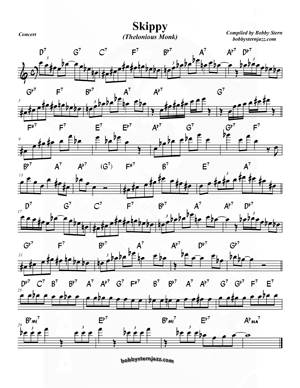NOT Peanut But Uhhh...
Thelonious Monk's "Skippy"

The melody alone, which is uncharacteristically dense by Monk standards, is a workout in and of itself.
Harmonically, the descending cycle of 5ths and chromatic tritone subs require considerable "'shedding" in order to confidently negotiate improvised lines through the changes.
In this post, we'll just concentrate on the head, with the rest to follow.
"Skippy" is 32 bars long with what appears to be an A1-B-A2-C song form. The tune is Monk's reharmonization and abstraction of Vincent Youmans' well known standard, "Tea for Two", which due to the melodic consistency between the sections, comes off more like an A1-A2-A3-B form.
The original "Tea", being in the key of Ab, moves temporarily to C for the second eight bars, then back again to Ab.
With all the cyclic motion in "Skippy", which starts on a D7 chord (the bV7 of Ab), the perceived key center of the melodic line still seems to be Ab, as in the original; especially for the first, third and last 8 bar sections.
The key center or the second 8 (measures #9-16) of "Skippy", however, is somewhat more ambiguous.
As in "Tea for Two", the start of the second 8 bar section of "Skippy" modulates up a Maj. 3rd, (starting on an F#7 in measure 9, again a bV7 chord, this time of the key of C). It seems as if Monk just used this as a starting point, because any subsequent harmonic or melodic reference to the key of C in this section, to my eyes and ears at least, is anecdotal at best.
Instead, Monk employs three 2 bar descending chromatic mini-cycles, each moving up a whole step from the previous one (Gb7-F7-E7-Eb7, Ab7-G7-F#7-F7, Bb7-A7-Ab7-G7 before cycling neatly and logically back to D7 (bV7 of Ab again) via F#7-B7-E7-A7 in measures #15 & 16.
Measures #17-22 are a facsimile of #1 through 6, with #23 & 24 setting up the mad dash to the finish line in bars #25-32, including the doubled chromatic eighth notes, with descending dominant 7th chords on every beat.
Whew!
I compiled a downloadable lead sheet from several transcriptions which were already available. The minor discrepancies between them seemed to stem from whether the transcriber used Monk's piano version of the head at the beginning of the original 1952 recording, or the ensemble horn version at the end of it, which has several small notational and rhythmic differences. See if you can hear them in the linked vid below.
For the most part, I tended to favor the former, since Monk, of course, wrote it; but used bits of the latter as well.
Most interesting (and challenging) to me is the phrase in bars #9-10. All of the notes in that 2 bar phrase belong to an A# half tone / whole tone diminished scale and which is transposed up a whole step in measures #~11-12 (C ht / wt dim scale). Don't forget, this is 1952 and the diminished scale was not yet a common part of the music's still growing vocabulary. The phrase still sounds as hip now as it might have sounded strange then.
Likewise, bars #13-14, which employ descending chromatic trichords in perfect 4ths; also not common at the time.
A note to tenor players: "Skippy" was obviously not written with the tenor saxophone in mind and therefore, some range adjustments are necessary. In the Bb lead sheet below, I didn't make any range adjustments, which as a consequence, necessitate interval jumps to high G, G# & A; challenging but by no means impossible; something that I'm striving for. Use whatever range is comfortable for you.
Please excuse any C flats, F flats, B sharps & E sharps. I know that several of them got away on some of the parts.
| Monk's original from 1952 | Steve Lacy (not 'Trane) on soprano from 1957 (w/ Elvin Jones & Mal Waldron). |
| Anthony Braxton on Alto | Ravi Coltrane's group, live from 2012 |

 RSS Feed
RSS Feed









